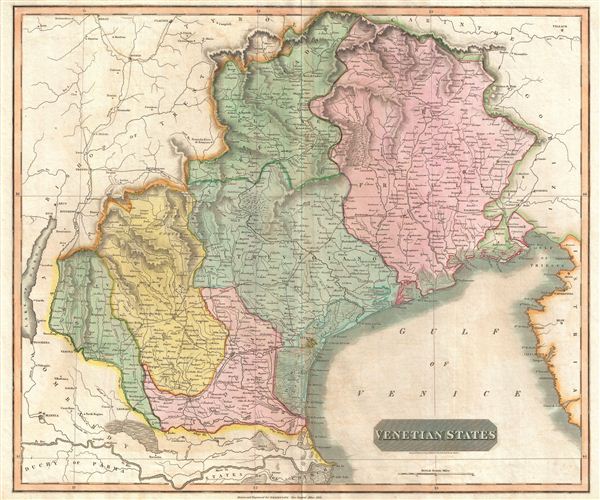1816 Thomson Map of Venice and Environs, Northern Italy
VenetianStates-thomson-1816
Title
1816 (dated) 19.75 x 23.5 in (50.165 x 59.69 cm) 1 : 410000
Description
A Closer Look
This map was produced in a period of significant changes, which had not been fully fleshed out, reflected in the somewhat vague and non-committal title. After being conquered by Napoleon, the Republic of Venice was abolished after more than a millennium of existence, as were neighboring territories. Lands changed hands quickly during the Napoleonic Wars, and at the Congress of Vienna, Habsburg Austria was given indirect control of the region through the newly created Kingdom of Lombardy-Venetia. The new state quickly became a target of Italian nationalists and was defunct within 50 years.Publication History and Census
This map was engraved in 1816 by Nathaniel Rogers Hewitt for inclusion in the 1817 (first) edition of John Thomson's New General Atlas. It is not independently cataloged among the holdings of any institution aside from the David Rumsey Historical Map Collection, while Thomson's entire atlas is more widely distributed in institutional collections.CartographerS
John Thomson (1777 - c. 1841) was a Scottish cartographer, publisher, and bookbinder active in Edinburgh during the early part of the 19th century. Thomson apprenticed under Edinburgh bookbinder Robert Alison. After his apprenticeship, he briefly went into business with Abraham Thomson. Later, the two parted ways, John Thomson segueing into maps and Abraham Thomson taking over the bookbinding portion of the business. Thomson is generally one of the leading publishers in the Edinburgh school of cartography, which flourished from roughly 1800 to 1830. Thomson and his contemporaries (Pinkerton and Cary) redefined European cartography by abandoning typical 18th-century decorative elements such as elaborate title cartouches and fantastic beasts in favor of detail and accuracy. Thomson's principle works include Thomson's New General Atlas, published from 1814 to 1821, the New Classical and Historical Atlas of 1829, and his 1830 Atlas of Scotland. The Atlas of Scotland, a work of groundbreaking detail and dedication, would eventually bankrupt the Thomson firm in 1830, at which time their plates were sequestered by the court. The firm partially recovered in the subsequent year, allowing Thomson to reclaim his printing plates in 1831, but filed again for bankruptcy in 1835, at which time most of his printing plates were sold to A. K. Johnston and Company. There is some suggestion that he continued to work as a bookbinder until 1841. Today, Thomson maps are becoming increasingly rare as they are highly admired for their impressive size, vivid hand coloration, and superb detail. More by this mapmaker...
Samuel John Neele (July 29, 1758 - May 13, 1824) was a prolific British map engraver active in the late 18th and early 19th centuries. Neele apprenticed as a printer and engraver with Harry Ashby from about 1781 to 1782 before establishing himself independently in 1785 at 352 Strand, London. The combination of business acumen and technical skill made Neele extremely successful with literally hundreds of maps to his credit. His vast corpus was composed of notable maps by most major English publishers of the period including, Haywood, Faden, Wallis, Stockdale, Arrowsmith, Thomson, Pinkerton, and Greenwood, among others. Neele's sons, James and Josiah Neele, also engravers, took over their fathers business around 1818, both becoming notable in their own right. Learn More...

